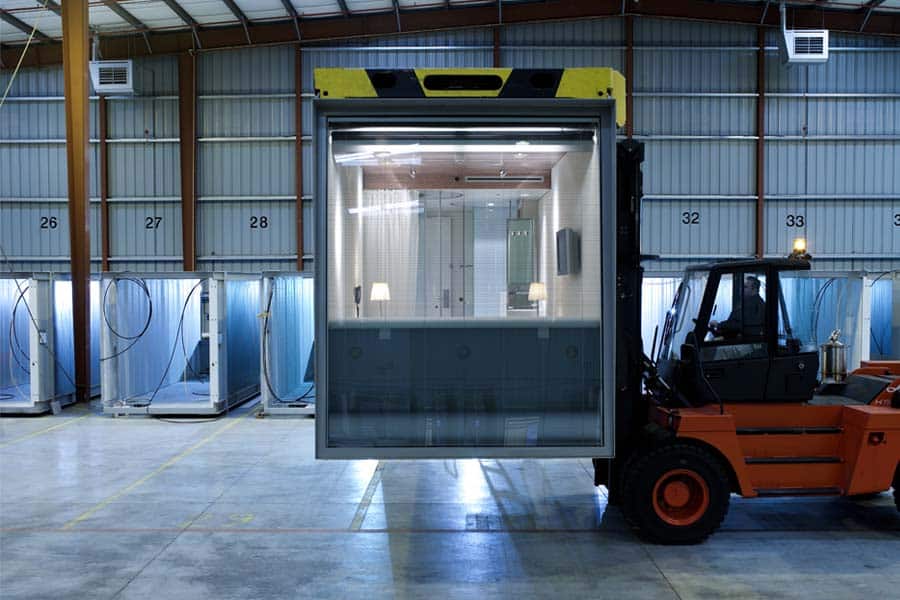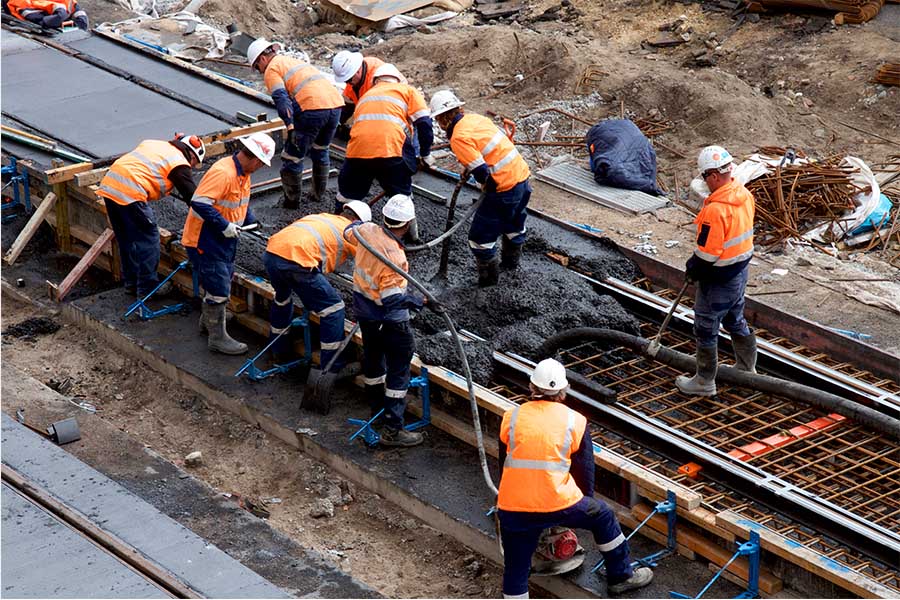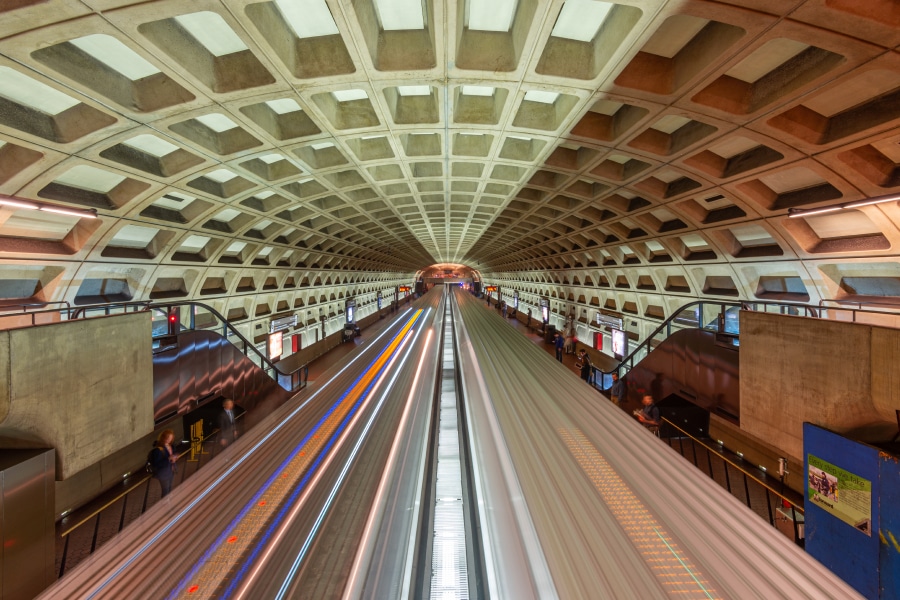At first glance, CitizenM looks like any other international hotel chain: stylish, efficient, with outposts catering to business travelers and leisurely globetrotters in cities around the world, from Paris to San Francisco to Copenhagen and Kuala Lumpur.
But behind the curtain is a special distinction—many of the hotels are modular in their construction, with the newest Los Angeles building composed from prefabricated rooms, craned into place like a child’s building blocks.
This unusual construction method not only allowed CitizenM to continue building during the worst of the Southern California city’s battle with the COVID-19 pandemic, but it’s an innovation that proponents argue provides for a faster, more streamlined building process, allowing CitizenM to quickly establish a global footprint.
By frequent travelers, for frequent travelers
The inspiration for the hotel chain’s modular model came from its founders’ disappointment with the hotel industry.
“We were a small startup in Holland, with a group of people that were frequent travelers, and we were all frequently disappointed and frustrated with what we found in the hotel industry,” said Menno Hilberts, CitizenM’s West Coast project director. “The ones we could afford were disappointing and sort of bland and gray, and the ones they liked were unaffordable.”
Hilberts and his team knew it needed to come up with a concept that combined affordability with luxury to create the hotel experience they craved. “We really started designing with a blank canvas, asking what we needed to create a good hotel,” Hilberts said.
ALSO ON BUILT:
The team decided it wanted to create a standardized room type oriented toward frequent travelers. “We need a really good night sleep, basically, and we don’t need a lot of bells and whistles, and a lot of hurdles. We need a seamless experience,” Hilberts said.
To create a standardized experience for international travelers, Hilberts and team knew they’d have to think outside the box. Thus the idea of a modular hotel was born.
Modular thinking
The CitizenM team’s search for consistent room design quickly led it to Amsterdam-based design and architecture studio Concrete. “They had this wild idea of doing a modular guest room in exactly the size of a 20-foot container,” Hilberts said. “So we said, ‘Hey, let’s do shipping containers.”
Concrete and CitizenM worked together to envision the modular concept. “You want to use your guest room as a bedroom, much like you would use at home,” Hilberts said. “You’d have to have a place to sleep, a great shower and a great bath, but you don’t need 250 square feet of nothingness and a couch and tables you’ll never use. Let’s get the basics done super well.”
Streamlining the bedroom space would allow CitizenM to focus on creating a luxury experience in the shared spaces of the hotel.
Once the team articulated its aesthetic and functional priorities, the real design challenges began. “We actually had industrial designers look at the room, as opposed to architects,” Hilberts said. “We needed to figure out how to design the rooms in a way that could be mass produced, without creating a lot of unused space.”
Having successfully created an easily reproducible modular hotel room design, Hilberts said the team stuck to its commitment to a purely industrial-design-based construction process for the first couple of years of CitizenM’s existence, before moving to a more hybrid model as the chain expanded across the world.
A streamlined process
The L.A. hotel, which recently opened its doors on the corner of Fourth and Spring Street in the city’s downtown, actually began in the factory of a Chinese supplier that assembled each modular room. The rooms then journeyed across the sea to the Port of Los Angeles.
“If you opened the door to any of the rooms on the vessel, you would have seen a finished module, almost entirely complete,” Hilberts said. “It has all the lighting fixtures, the surfaces, even the furniture, which is built into the rooms. Everything is attached to the wall but a single loose stool that’s tucked under a desk. There’s no mattress in there, and the fire alarm is not connected, but everything else is complete.”
The rooms have even been inspected according to local building codes by a California state inspector who flies out in advance to the factory in China. “The connections need to be inspected on site,” Hilberts said. “But all the internal components arrive inspected and approved.”
There’s a lot of planning and discussion that takes place behind the scenes of every streamlined building project. “We’ve got six months of construction administration between the modular supplier and the architect before a contractor starts,” Hilberts said. “We definitely put in Bluebeam Studio Sessions to get us to a place where we can start this thing.”
‘Lego block’ construction
Once the shipping containers arrive, the real fun begins.
The process is so entertaining to observe that CitizenM sets up a livestream of its construction sites where people can watch the buildings come together, floor by floor. “Each floor is designed with a similar layout: two guest rooms, with a little bit of corridor in the middle, ” Hilberts said. “The typical structure we have in a modular building is that we build a ‘table,’ which houses our lobby, and we stack Lego boxes on top.”
Every modular hotel CitizenM builds looks similar, although the dimensions and design of the exterior may vary slightly from each location.
“If you looked at the video of the downtown L.A. hotel being constructed, you’d literally see a podium, which is a traditional construction of a concrete transfer deck with a concrete elevator sticking out. We come in and stack Lego boxes on top of it, adding 10 or 12 layers a day, which means we’re building anywhere between 20 and 40 finished guest rooms in the day. So, in about a week, you’ll see a floor of the building come together, and soon a completed structure.”
As exciting as it is to watch on the livestream, the modular nature of the L.A. hotel isn’t typical of all CitizenM’s projects. “When we really started to roll out internationally, it became apparent that this whole idea of sending buildings halfway across the world and stacking them together was a bit naive,” Hilberts said. While the model worked wherever the CitizenM team wanted to build a hotel, sometimes local regulatory conditions made the building method impractical. Today, Hilberts said that around 30% of the hotels CitizenM builds are modular. As modular hotel building and construction continues to gain popularity and acceptance around the world, that number may continue to grow, he said.












